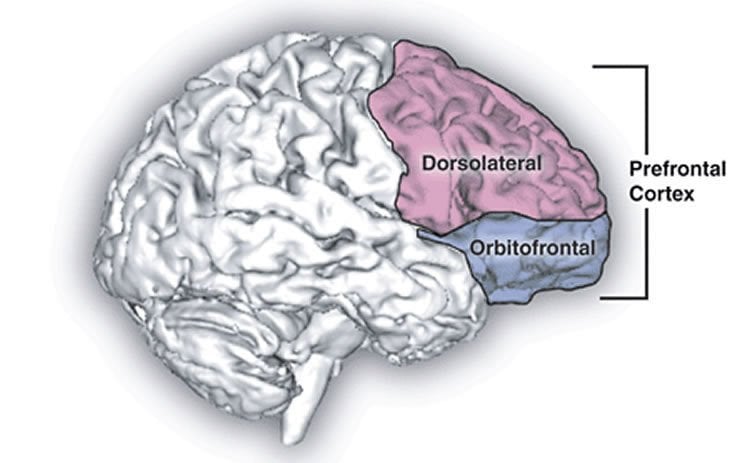Summary: Using repetitive transcranial magnetic stimulation, researchers report they are able to strengthen or weaken the processing of negative emotions.
Source: Elsevier.
A new study published in Biological Psychiatry: Cognitive Neuroscience and Neuroimaging reports that processing of negative emotion can be strengthened or weakened by tuning the excitability of the right frontal part of the brain.
Using magnetic stimulation outside the brain, a technique called repetitive transcranial magnetic stimulation (rTMS), researchers at University of Münster, Germany, show that, despite the use of inhibitory stimulation currently used to treat depression, excitatory stimulation better reduced a person’s response to fearful images.
The findings provide the first support for an idea that clinicians use to guide treatment in depression, but has never been verified in a lab. “This study confirms that modulating the frontal region of the brain, in the right hemisphere, directly effects the regulation of processing of emotional information in the brain in a ‘top-down’ manner,” said Cameron Carter, M.D., Editor of Biological Psychiatry: Cognitive Neuroscience and Neuroimaging, referring to the function of this region as a control center for the emotion-generating structures of the brain. “These results highlight and expand the scope of the potential therapeutic applications of rTMS,” said Dr. Carter.
In depression, processing of emotion is disrupted in the frontal region of both the left and right brain hemispheres (known as the dorsolateral prefrontal cortices, dlPFC). The disruptions are thought to be at the root of increased negative emotion and diminished positive emotion in the disorder. Reducing excitability of the right dlPFC using inhibitory magnetic stimulation has been shown to have antidepressant effects, even though it’s based on an idea–that this might reduce processing of negative emotion in depression–that has yet to be fully tested in humans.
Co-first authors Swantje Notzon, M.D., and Christian Steinberg, Ph.D, and colleagues divided 41 healthy participants into two groups to compare the effects of a single-session of excitatory or inhibitory magnetic stimulation of the right dlPFC. They performed rTMS while the participants viewed images of fearful faces to evoke negative emotion, or neutral faces for a comparison.

Excitatory and inhibitory rTMS had opposite effects–excitatory reduced visual sensory processing of fearful faces, whereas inhibitory increased visual sensory processing. Similarly, excitatory rTMS reduced participants’ reaction times to respond to fearful faces and reduced feelings of emotional arousal to fearful faces, which were both increased by inhibitory rTMS.
Although the study was limited to healthy participants, senior author Markus Junghöfer, Ph.D., notes that “…these results should encourage more research on the mechanisms of excitatory and inhibitory magnetic stimulation of the right dlPFC in the treatment of depression.”
Source: Rhiannon Bugno – Elsevier
Publisher: Organized by NeuroscienceNews.com.
Image Source: NeuroscienceNews.com image is in the public domain.
Original Research: Abstract in Biological Psychiatry: Cognitive Neuroscience and Neuroimaging.
doi:10.1016/j.bpsc.2017.12.007
[cbtabs][cbtab title=”MLA”]Elsevier “Magnetic Brain Stimulation Alters Negative Emotional Perceptions.” NeuroscienceNews. NeuroscienceNews, 6 February 2018.
<https://neurosciencenews.com/rtms-negative-perceptions-8441/>.[/cbtab][cbtab title=”APA”]Elsevier (2018, February 6). Magnetic Brain Stimulation Alters Negative Emotional Perceptions. NeuroscienceNews. Retrieved February 6, 2018 from https://neurosciencenews.com/rtms-negative-perceptions-8441/[/cbtab][cbtab title=”Chicago”]Elsevier “Magnetic Brain Stimulation Alters Negative Emotional Perceptions.” https://neurosciencenews.com/rtms-negative-perceptions-8441/ (accessed February 6, 2018).[/cbtab][/cbtabs]
Abstract
Modulating emotion perception – Opposing effects of inhibitory and excitatory prefrontal cortex stimulation
Background
Excitatory transcranial magnetic stimulation (rTMS) of the left dorsolateral prefrontal cortex (dlPFC) is approved by the US Food and Drug Administration for the treatment of adult patients’ suffering from treatment-resistant major depressive disorder (MDD).
This stimulation is supposed to restore excitability of prefrontal cortex regions that exhibit diminished regulation of emotion-generative systems in MDD.
Based on the “valence lateralization hypothesis”, inhibitory rTMS of the right dlPFC has also been applied in MDD. This approach has proved to be effective, although meta-analyses of emotional perception and affective regulation in healthy controls and depressive patients do not support functional asymmetries within dlPFC regions.
Methods
To shed more light on this discrepancy, the effects of excitatory and inhibitory rTMS of the right dlPFC on visual emotional perception were compared in two groups of overall 41 healthy participants. Before and after rTMS stimulation participants viewed fearful and neutral faces, while whole-head magnetoencephalography was recorded and supplemented by behavioral tests.
Results
Visual sensory processing of fearful, relative to neutral facial expressions, was reduced after excitatory stimulation and increased after inhibitory stimulation within right occipital and right temporal regions. Correspondingly, after excitatory compared to inhibitory rTMS, participants displayed relatively reduced reaction times in an emotion discrimination task and reduced emotional arousal.
Conclusions
These results support the hypothesis that excitatory compared to inhibitory rTMS of the right dlPFC strengthens top-down control of aversive stimuli in healthy controls, which should encourage more research on mechanisms of excitatory/inhibitory dlPFC-rTMS protocols in general and on neuromodulatory treatment of MDD.






